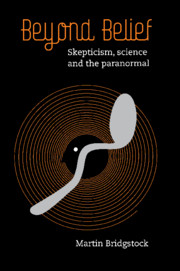Book contents
- Frontmatter
- Contents
- Preface
- Introduction: The paranormal and why it matters
- Chapter 1 The nature of science
- Chapter 2 The paranormal
- Chapter 3 Skepticism – from Socrates to Hume
- Chapter 4 Modern skepticism
- Chapter 5 Bringing skepticism down to earth
- Chapter 6 Skepticism, ethics and survival
- Chapter 7 Skepticism beyond the paranormal
- Bibliography
- Index
Chapter 5 - Bringing skepticism down to earth
Published online by Cambridge University Press: 05 April 2010
- Frontmatter
- Contents
- Preface
- Introduction: The paranormal and why it matters
- Chapter 1 The nature of science
- Chapter 2 The paranormal
- Chapter 3 Skepticism – from Socrates to Hume
- Chapter 4 Modern skepticism
- Chapter 5 Bringing skepticism down to earth
- Chapter 6 Skepticism, ethics and survival
- Chapter 7 Skepticism beyond the paranormal
- Bibliography
- Index
Summary
In the previous chapter, we looked at the key principles of modern skepticism. Between them, they provide a foundation for a skeptical outlook on the paranormal and, as we shall see, on the world generally. However, if the reader tries to apply these concepts directly to the paranormal, there is likely to be disappointment. The ideas are far too general to apply to most paranormal claims. For example, Sagan's balance states that the evidence must be sufficiently strong to justify an extraordinary belief.
But how does one decide exactly what the evidence is, or whether it is strong enough? The general statements give little guidance. Clearly, another step is needed between the general skeptical principles and the actual paranormal claims. For any claim, the skeptic has to understand the main ideas involved in the claim, the main skeptical ideas that can be brought to bear, and the evidence which is involved. There is no shortcut or easy way, although some approaches are better than others. We will call this new set of ideas ‘intermediate concepts’ as they stand between general skeptical principles and the amazing range of paranormal claims.
Paranormalists who approach me are often disappointed. They proffer some sort of evidence (‘My friend saw a UFO!’, or similar) and expect me to be able to demolish the claim there and then, or else to concede that the claim is justified. In fact, of course, this is impossible.
- Type
- Chapter
- Information
- Beyond BeliefSkepticism, Science and the Paranormal, pp. 111 - 139Publisher: Cambridge University PressPrint publication year: 2009



